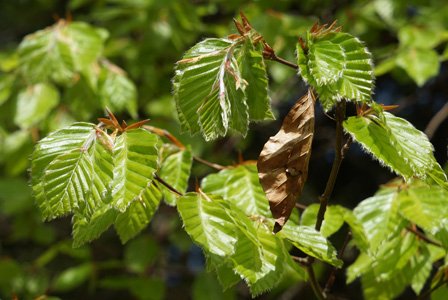Forest Pests and Diseases of Beech
The forest health situation in common beech is generally considered not a problem by forest owners and forest protection experts. However, a closer look at the available literature on abiotic and biotic damages affecting beech trees reveals that this is not really the case. There are quite some reports on large damages affecting this tree species in Europe.
Beech bark disease
Beech bark disease is a recurrent phenomenon which is closely related to extreme dry weather and frost. The results are wilting of leafs, dieback of twigs and branches, sap flow at the stem and infestation by secondary insects or fungi. The composition of the pest and disease complex differs according to region and cannot always be clearly assigned. Sap flow is also possible without participation of insects and fungi. Mostly, it is associated with infestation by Phytophthora or by the metallic wood-boring beetle. If landowners wait too long to remove damaged trees they risk a drastic reduction of the timber value, including new infestation of healthy trees.
Abiotic bark damages
Beech does not tolerate bark damages. Sudden exposure to the open field results in "sun burn", followed by cracks in the bark and infestation by secondary fungi and insects. Logging injuries cause similar problems that have become quite common by now in forest.
Major insect pests of beech
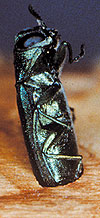
Beech buprestid (Agrilus viridis)
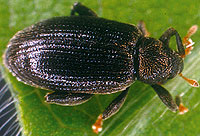
Rynchaeus fagi
Bark beetles
The two most important bark beetles in common beech are Typhorychus bicolour and Ernoporus fagi. Both species belong to the group of small bark beetles (1.5 to 2.2 mm), though differing in appearance and breeding behaviour. They infest more or less weakened trees, but they may also attack healthy trees during a mass outbreak. Since the drought of 2003, we noted pronounced occurrence of T. bicolor in many parts of Austria. Many times, dying beech trees were cut for fuel wood and the infested timber was stored in the forest resulting in further spread of the infestation.
Wood-boring beetles
Among the wood breeding bark beetles, the most important is Trypodendron domesticum. The beetle bores tunnels into the wood causing major wood decay. T. domesticum and Anisandrus dispar may cause physiological injuries. Both species attack also saplings and young plants. In case of heavy infestation – and apart from increased risk of tree break – the sap flow is interrupted even in trees up to a diameter of 6 cm, followed by dieback of the trees. Also here it is important to quickly remove already infested wood.
Long-horned beetles
Hylecoetus dermestoides is another common wood pest. Like some other long-horned beetles infesting beech, Cerambyx scopolii is known to be very dangerous, last but not least for its frequent occurrence. It causes not only the ruin of sick and weak trees in each age class but can also drastically reduce the value of stored timber with sufficient rest humidity by boring hooked tunnels far into the sapwood.
Beech buprestid
The Beech buprestid (Agrilus viridis) is a major problem for abiotically wounded trees or younger plants. The beetle kills even less weakened trees. Infestation can be easily recognised from its sidled tunnels, mainly located at the stem. The insect pest occurs typically after warm and dry periods. Infested stems must be hauled in time (before the flight of the beetle) and removed from the forest.
Rynchaeus fagi
Rynchaeus fagi is a small weevilthe larvae of which arrange characteristic mines in leaves of beech trees (the sidled tunnel turns later on into an extensive mine). Larvae feed on leaves and can be found during mass outbreaks in neighbouring fruit orchards. During gradations striking injuries similar to late frost may appear, but they only cause increment losses. Control measures are not possible and would be useless.
Sucking insects
The felted beech coccus (Cryptococcus fagi) and Phyllapsis fagi are the most significant sucking insect pests.
Cryptococcus fagi
is said to be precursor of diseases such as beech bark dieback and Phytophthora infections. Phylapsis fagi is less dangerous, but it can cause the dieback of beech seedlings. Galls of the upper leave surfaces are completely harmless but their appearance is striking nonetheless. They are caused by the beech smooth-pouch-gall midge (Mikiola fagi).
Important fungi diseases
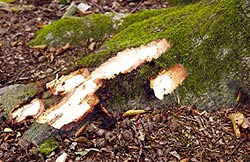
The most common is Phytophthora cambivora destroying the fine roots first, later on the main roots and finally the bark at the stem base
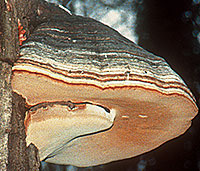
Tinder fungus (Fomes fomentarius)
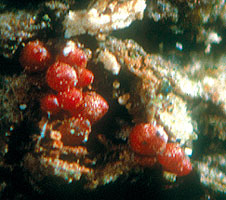
The red ball-shaped fruiting bodies of Nectria coccinea
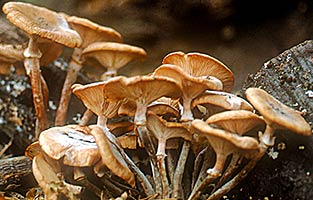
The red ball-shaped fruiting bodies of Nectria coccinea
Phytophthora infestation
During the last decade the Phytophthora infestation has increased enormously throughout Europe. Two different Phytophthora diseases with varying damage symptoms cause major damages and dieback of beech trees. The most common is Phytophthora cambivora destroying the fine roots first, later on the main roots and finally the bark at the stem base. In addition to dieback of crown, a typical sign is sap flow at the root collar and the stem base under which the bark tissue is already dead. Often, decaying agents such as Honey fungus (Armillaria sp.), Tinder fungus (Fomes fomentarius), Ganoderma sp. or Coal fungus (Hypoxylon deustum or Ustulina deusta) colonise the destroyed bark tissue.
Different from the mortal root disease caused by Phytophthora cambivora, infestation by P. citricola is characterised by high risk of tree break. The spores are transported by snails into upper stem regions where they invade the bark tissue as mycelium through cracks and smaller injuries. There, they cause bark lesions of several meters in length. Successive infestation by decaying fungi such as Tinder fungus increases the risk of tree break.
In addition to the already described occurrence of Phytophthora infestation, the Tinder fungus (Fomes fomentarius) is a classical agent of wound rot, a common disease in the Vienna Woods. The fruiting body appears high up at the stem and produces more or less continuously large quantities of spores. Fissures caused by lightning, frost, injuries from wind break on starlings’ nest boxes as well as felling damages are typical infection possibilities. Consistent hygiene measures such as regular hauling of infested stems may force back an infestation by Tinder fungus in beech stands for longer periods.
Nectria bark diseases
Several Nectria species cause bark injuries and canker in beech. Nectria coccinea colonises frequently stem lesions after Phytophthora infestation. The red ball-shaped fruiting bodies or the whitish tendrils of spores are quite striking. It also causes beech bark necrosis, the infection vector being wooly aphids sucking at the stem. Nectria ditissima is responsible for canker in twigs, branches and at the stem. Nectria cinnabarina, the Coral Spot disease, may cause the dieback of twigs. But it can more frequently be found on dead fine twigs lying on the floor.
Honey fungus (Armillaria sp.) is known above all as a direct successor of drought stress. In addition to the fruiting bodies, the genre can easily be recognised by its black, ropy strands of mycelium (rhizomorphes) between the dead bark and the wood of the stem.
Ascodichaena rugosa, can be recognised due to the striking black large scale strips on beech stems. However, it causes only superficial injuries on the bark.
Fungi of leaves
Thebeech anthracnose(Apiognomonia errabunda) is the most frequent fungus species causing dieback of beech. The micro fungus invades normally living beech leaves without producing any symptoms. It can spread suddenly in the leaf due to stab wounds of gall producing insects in cool, precipitation-rich weather, causing fall of leaves in early summer. However, this fungus species may not become a serious danger for adult beeches.
Summary
Abiotic causes, complex diseases, fungi and insects may cause major damages in beech. Therefore, this problem should more seriously be addressed by forest practice in order to avoid large scale damages in beech stands, involving a reduction of the value of timber.

